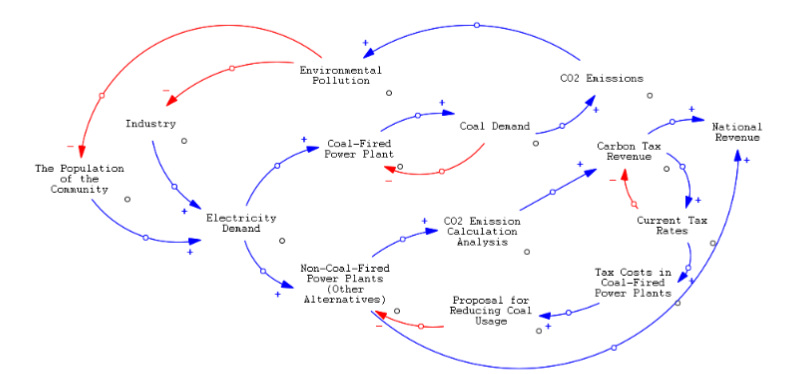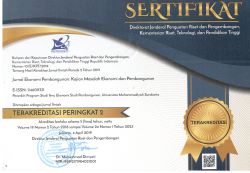The Impact of Coal Power Plant Emissions on Indonesia's Carbon Tax Rates
DOI:
https://doi.org/10.23917/jep.v26i1.10686Keywords:
Carbon Tax, Coal-Fired Power Plants, Emissions, System ThinkingAbstract
Indonesia, as one of the top ten global carbon emitters, largely due to its heavy reliance on coal-fired power plants, has introduced a carbon tax policy to address the environmental impacts and mitigate carbon emissions. This study investigates the dynamic effects of coal power plant emissions on Indonesia's carbon tax rates by applying a system thinking approach utilizing a Causal Loop Diagram (CLD). The CLD is used to map the complex interactions between carbon emissions, economic factors, and regulatory policies, focusing on Indonesia’s carbon tax policy framework from its inception in 2021 through its early implementation stage in 2022, with projections extending to 2025. The CLD analysis identifies three key feedback loops : a reinforcing loop where economic growth and electricity demand increase coal consumption and CO2 emissions, a balancing loop where carbon tax revenues stimulate renewable energy investments to reduce fossil fuel dependency, and a policy feedback loop that strengthens fiscal capacity for climate mitigation efforts. Scenario analysis suggests that increasing the carbon tax rate from IDR 30/kg CO2e to IDR 150/kg CO2e could significantly reduce emissions while maintaining economic stability, particularly in the energy sector, if accompanied by targeted subsidies and incentives for renewable energy. The findings contribute new policy insights on how carbon taxes can be optimized to achieve environmental conservation goals while minimizing negative economic impacts and promoting a sustainable energy transition in Indonesia.
Downloads
References
Abeydeera, U., Mesthrige, J. W., & Samarasinghe, T. (2019). Global Research on Carbon
Emissions: A Scientometric Review. Sustainability, 11(14), 3972.
https://doi.org/10.3390/su11143972
Acaroglu, L. (2017). Tools for Systems Thinkers: The 6 Fundamental Concepts of Systems
Thinking. Disruptive Design. https://medium.com/disruptive-design/tools-forsystems-thinkers-the-6-fundamental-concepts-of-systems-thinking-9b4d8a0b3c8e
Aditama, R. (2022). Kebijakan Ketenagalistrikan di Bidang Perlindungan dan Pengelolaan
Lingkungan Hidup Sejak Berlakunya Undang-Undang Cipta Kerja: Studi pada
PLTU Batubara Tarahan. Universitas Lampung.
Azis, R., Nurhayati, N., & Nurleli. (2023). The Contribution of Carbon Taxes to Economic
Progress in Indonesia. JRB - Jurnal Riset Bisnis, 7(1), 78–92.
https://doi.org/10.35814/jrb.v7i1.5536
Baskoro, F. R., Takahashi, K., Morikawa, K., & Nagasawa, K. (2022). Multi-objective
optimization on total cost and carbon dioxide emission of coal supply for coal-fired
power plants in Indonesia. Socio-Economic Planning Sciences, 81, 101185.
https://doi.org/10.1016/j.seps.2021.101185
Cahyono, W. E., Parikesit, Joy, B., Setyawati, W., & Mahdi, R. (2022). Projection of CO2
emissions in Indonesia. Materials Today: Proceedings, 63(Supplement 1), S438–
S444. https://doi.org/10.1016/j.matpr.2022.04.091
Cornot-Gandolphe, S. (2016). Indonesia’s Electricity Demand and the Coal Sector: Export
or meet domestic demand? https://doi.org/10.26889/9781784670795
Dat, N. D., Hoang, N., Huyen, M. T., Huy, D. T. N., & Lan, L. M. (2020). Energy
Consumption and Economic Growth in Indonesia. International Journal of Energy
Economics and Policy, 10(5), 601–607. https://doi.org/10.32479/ijeep.10243
Forster, P., Ramaswamy, V., Artaxo, P., Berntsen, T., Betts, R., Fahey, D. W., Haywood, J.,
Lean, J., Lowe, D. C., Myhre, G., Nganga, J., Prinn, R., Raga, G., Schulz, M., & Van
Dorland, R. (2007). Changes in Atmospheric Constituents and in Radiative Forcing.
Chapter 2. In S. Solomon, D. Qin, M. Manning, Z. Chen, M. Marquis, K. B. Averyt,
M. Tignor, & H. L. Miller (Eds.), Climate Change 2007: The Physical Science Basis
(pp. 129–234). Cambridge University Press.
Global Carbon Atlas Team. (2023). Global Carbon Budget, 2023 Edition.
https://www.globalcarbonatlas.org
Hidayatno, A., Dhamayanti, R., & Destyanto, A. R. (2019). Model conceptualization for
policy analysis in renewable energy development in Indonesia by using system
dynamics. International Journal of Smart Grid and Clean Energy, 8(1), 54–58.
https://doi.org/10.12720/sgce.8.1.54-58
International Energy Agency. (2020). Global CO2 Emissions in 2019. International Energy
Agency. https://www.iea.org/reports/global-co2-emissions-in-2019
Investor Daily. (2021). Pajak Karbon. Investor Daily. https://investor.id/
Irama, A. B. (2020). Perdagangan Karbon di Indonesia: Kajian Kelembagaan dan
Keuangan Negara. Jurnal Ilmu Administrasi, 4(1).
https://doi.org/10.31092/jia.v4i1.741
Kuziboev, B., Rajabov, A., Ibadullaev, E., Matkarimov, F., & Ataev, J. (2024). The role of
renewable energy, tax revenue and women governance in environmental degradation
for developing Asian countries. Energy Nexus, 13, 100262.
https://doi.org/10.1016/j.nexus.2023.100262
Lin, B., & Li, X. (2011). The effect of carbon tax on per capita CO2 emissions. Energy Policy,
39(9), 5137–5146. https://doi.org/10.1016/j.enpol.2011.05.050
Lismiyah, E., Marselina, M., Taher, A. R., Gunarto, T., & Aida, N. (2024). The Causality
Between Energy Consumption and Carbon Emission in Indonesia. Jurnal Riset Ilmu
Ekonomi, 4(1), 27–38. https://doi.org/10.23969/jrie.v4i1.83
Mutia, A. (2022). 10 Negara Penyumbang Emisi Karbon Terbesar di Dunia, Ada Indonesia!
Katadata Media Network. https://www.katadata.co.id/
NASA. (2024). The Causes of Climate Change. https://science.nasa.gov/climatechange/causes/
National Centers for Environmental Information (NCEI). (2022). Annual 2022 Global
Climate Report. https://www.ncei.noaa.gov/access/monitoring/monthlyreport/global/202213
Oktavilia, S., Puspita, D. W., Firmansyah, & Sugiyanto, F. (2018). The Relationship
Between Environmental Degradation, Poverty and Human Quality in Indonesia. E3S
Web of Conferences, 73(1), 10020. https://doi.org/10.1051/e3sconf/20187310020
Organisation for Economic Co-operation, & (OECD), D. (2023). Environment at a Glance
Indicators. OECD Publishing. https://www.oecd.org/en/publications/environment-ata-glance-indicators_ac4b8b89-en.html
Pamungkas, B. N., & Haptari, V. D. (2022). Analisis Skema Pengenaan Pajak Karbon Di
Indonesia Berdasarkan United Nations Handbook Mengenai Penerapan Pajak
Karbon Oleh Negara Berkembang. JURNAL PAJAK INDONESIA (Indonesian Tax
Review), 6(2), 357–367. https://doi.org/10.31092/jpi.v6i2.1843
Prahasta, E. (2018). Systems Thinking & Pemodelan Sistem Dinamis (Cet. 1). Informatika
Bandung.
Pujiati, A., Yanto, H., Dwi Handayani, B., Ridzuan, A. R., Borhan, H., & Shaari, M. S.
(2023). The Detrimental Effects of Dirty Energy, Foreign Investment, and Corruption
on Environmental Quality: New Evidence from Indonesia. Frontiers in
Environmental Science, 10, 1074172. https://doi.org/10.3389/fenvs.2022.1074172
Putra, J. J. H., Nabilla, N., & Jabanto, F. Y. (2021). Comparing “Carbon Tax” and “Cap and
Trade” as Mechanism to Reduce Emission in Indonesia. International Journal of
Energy Economics and Policy, 11(5), 106–111. https://doi.org/10.32479/ijeep.11375
Ramadhani, D. P., & Koo, Y. (2022). Comparative Analysis of Carbon Border Tax
Adjustment and Domestic Carbon Tax Under General Equilibrium Model: Focusing
on the Indonesian Economy. Journal of Cleaner Production, 377, 134288.
https://doi.org/10.1016/j.jclepro.2022.134288
Ratnawati, D. (2016). Carbon Tax Sebagai Alternatif Kebijakan Untuk Mengatasi
Eksternalitas Negatif Emisi Karbon di Indonesia. Indonesian Treasury Review:
Jurnal Perbendaharaan, Keuangan Negara dan Kebijakan Publik, 1(2), 53–67.
https://doi.org/10.33105/itrev.v1i2.51
Sabubu, T. A. W. (2020). Pengaturan Pembangkit Listrik Tenaga Uap Batubara Di
Indonesia Prespektif Hak Atas Lingkungan Yang Baik Dan Sehat. Lex Renaissance,
5(1), 72–90. https://doi.org/10.20885/JLR.vol5.iss1.art5
Sapta, L. T., Junaidi, J., & Umiyati, E. (2024). Determinants of electricity demand in the
industrial and commercial sector in Indonesia. Jurnal Paradigma Ekonomika, 19(1),
60–67. https://doi.org/10.22437/jpe.v19i1.34640
Saputra, A. I., Limpato, J., & Kuswantoro, H. (2022). Carbon Pricing and its Monitoring
System as a State Revenue. Indonesian Treasury Review: Jurnal Perbendaharaan,
Keuangan Negara Dan Kebijakan Publik, 7(3), 207–223.
https://doi.org/10.33105/itrev.v7i3.456
Sarasi, V., Yulianti, D., & Farras, J. I. (2021). Berpikir Sistem dan Dinamika Sistem.
Penerbit Yayasan Sahabat Alam Rafflesia.
Stern, N. (2007). The Economics of Climate Change: The Stern Review. Cambridge
University Press.
Sumarno, T. B., & Laan, T. (2021). Taxing Coal to Hit the Goals: A simple way for Indonesia
to reduce carbon emissions. https://www.iisd.org/system/files/2021-08/taxing-coalindonesia-reduce-carbon-emissions.pdf
Suryani, E., Hendrawan, R. A., Adipraja, P. F. E., & Widodo, B. (2022). Dynamic scenario
to mitigate carbon emissions of transportation system: A system thinking approach.
Procedia Computer Science, 197(1), 635–641.
https://doi.org/10.1016/j.procs.2021.12.184
Thwink.org. (2014). Systems Thinking.
https://www.thwink.org/sustain/glossary/SystemsThinking.htm
Wafiq, A. N., & Suryanto, S. (2021). The Impact of Population Density and Economic
Growth on Environmental Quality: Study in Indonesia. Jurnal Ekonomi & Studi
Pembangunan, 22(2), 301–312. https://doi.org/10.18196/jesp.v22i2.10533
Wang, H., Li, L., Sun, J., & Shen, M. (2023). Carbon emissions abatement with duopoly
generators and eco-conscious consumers: Carbon tax vs carbon allowance. Economic
Analysis and Policy, 80, 786–804. https://doi.org/10.1016/j.eap.2023.09.022
Zhang, Z., Qu, J., & Zeng, J. (2008). A quantitative comparison and analysis on the
assessment indicators of greenhouse gases emission. Journal of Geographical
Sciences, 18, 387–399. https://doi.org/10.1007/s11442-008-0387-8

Submitted
Accepted
Published
How to Cite
Issue
Section
License
Copyright (c) 2025 Arif Rahman Hakim, Vita Sarasi, Eddy Prahasta

This work is licensed under a Creative Commons Attribution 4.0 International License.













